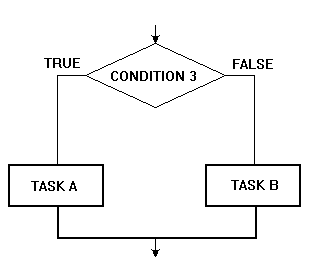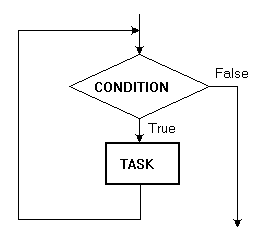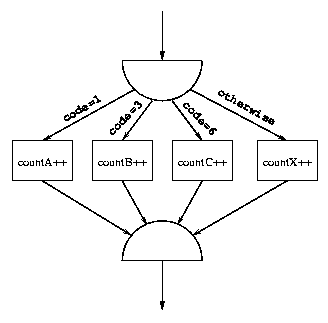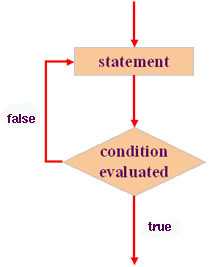
What is the difference between a novel and a book? They really aren't the same thing! A novel is a relatively long fictional prose story. A book is a bound collection of pages. A novel is often published as a book - but it can also exist on microfilm or be stored electronically. Thus a novel is an abstract entity, whereas a book is one concrete way of implementing that entity.
Control Logic Structures are similarly abstract. When we speak of the control logic structures of Sequence, Selection, and Repetition (illustrated below)
| Sequence |  |
| Selection |  |
| Repetition |  |
Why are these three control logic structures important? To explain fully, we first have to define the term proper program:
A Proper Program has the following four characteristics:Don't worry about the one entry/exit point stuff. No dead code means a program does not contain code that is inherently unreachable and thus unexecutable. No eternal loops means no loops that are designed to run forever.
- has one entry point,
- has one exit point,
- contains no dead code, and
- contains no eternal loops.
Please do not get hung up on the adjective proper; this is a formal term and does not mean "good" or "desirable" - it simply means the program possesses the four characteristics given above. However we will argue that proper programs are probably the only programs we are interested in coding, at least in this course. A program that never ends is not very useful (it is hard to hand in the execution results) and why would we want to insert dead code into a program?
Now that we know the formal meaning of proper program, and that these are the types of programs we want to construct, we finally get to what is probably the most significant discovery in computer science, at least as far as programming is concerned: the Structured Program Theorem. The Structured Program Theorem was first proven in 1966 by two Italian computer scientists, Corrado Böhm and Giuseppe Jacopini. However it went virtually unnoticed until Edsger Dijkstra wrote a paper in 1968 about the theorem's practical consequences. The following version of the the Structured Program Theorem is based on Linger, Mills, and Witt (1975):
The Structured Program Theorem - Any proper program can be constructed using only three control logic structures: sequence, selection, and repetition.
The major value of the Structured Program Theorem is in its proof that only a small set of control logic structures, suitably composed, can build any program we are interested in constructing. This is as important to computer science, as Dalton's atomic theory (that all matter in the universe is composed of atoms) was to chemistry.
The term Structured Programming was originally coined to describe the style of programming where programs were designed and built using only this limited set of control logic structures. You have been doing structured programming since the beginning of the course. Previously, you have been introduced to the if statement that provides a concrete way of implementing the selection control logic structure. You have also seen the while statement that provides a concrete way of implementing the repetition control logic structure. Sequence is provided by just listing one statement after another. Consequently, you have learned enough Python so that, in theory, you are now able to write a program to solve any problem you will ever be given!
Of course, theory is one thing and practice is another. For example, in theory, if you can walk, you can travel by foot to Alaska. But in practice, issues of cost and convenience are very important. Although all proper programs can be built using just the control logic constructs of sequence, selection, and repetition, it is convenient to add two additional control logic structures to our toolkit: case and repeat-until. We shall consider these two new constructs and ways of implementing them in Python, in the following sections.
However, many times in designing a program it is convenient to consider directing the flow of control among more than two alternatives. The case control logic structure, also called multiple alternation, involves selecting from multiple (more than two) alternative actions. For example, the following flowchart depicts a case control logic structure that increments different counters depending on the value of a code variable.
| Case |  |
The Python if statement provides
one concrete way of implementing
the case control logic structure.
The case flowchart logic above could be implemented with the following code:
if code==1:
countA+=1
else:
if code==3:
countB+=1
else:
if code==6:
countC+=1
else:
countX+=1
The indentation of the code above does a poor job, however, of
revealing the inherent case logic. That is, the indentation does
not clearly reveal that each incrementation is one of a set of
mutually exclusive alternatives.
The multiway if indentation scheme that also uses
the elif keyword would reveal this
much more clearly and compactly:
if code==1:
countA+=1
elif code==3:
countB+=1
elif code==6:
countC+=1
else:
countX+=1
To emphasize to someone reading the code that the same value
is being testing in each if statement, often the boolean expression
(predicate) in the first if is shifted a little to the
right so as to align with the following boolean expressions.
Also, a Python comment can be appended to the else
explaining the conditions under which the last alternative is executed.
The code would then look like this:
if code==1:
countA+=1
elif code==3:
countB+=1
elif code==6:
countC+=1
else: #otherwise
countX+=1
However, many times in designing a program it is convenient to use a loop in which the condition is tested at the end of the loop. The repeat-until control logic structure is a looping construct that exhibits such behavior. For this reason, we sometimes identify this as a one or more times loop, because the boolean expression is not even evaluated until one iteration of the loop has occurred. The following flowchart graphically depicts the repeat-until control logic structure. Notice that the loop is exited when the loop condition evaluates to true.
| Repeat-Until |  |
Interestingly, Python does not have a statement that exactly implements this abstract control logic structure! Many languages, such as Pascal and Ada, do have statements that directly implement the repeat-until control logic structure; in fact, in Pascal the statement is called the repeat-until statement. So why bring this up to Python programmers? Simply to point out once again that a control logic structure as a concept is different from the statement(s) that may implement the structure.
The repeat-until loop is not commonly used.
In the C programming language (used to implement UNIX),
the repeat-until construct is typically implemented using
something called a DO-WHILE statement.
A survey of the UNIX operating system software revealed that
of all the loops found in the code,
only about 4% were DO-WHILE loops.
The break statement
The break statement can appear inside
while and for loops.
Executing the break inside a loop interrupts the
flow of control by immediately exiting the loop.
That is, executing the break inside a loop
causes the program to skip straight to the statement following the loop.
Although the break statement exists in Python,
the circumstances where it would make sense to use the
break statement in a loop are uncommon and consequently
the break statement should be used with extreme caution.
One justifiable use of the break statement is when trying to implement a repeat-until loop in Python. (Although recall that the Structured Programming Theorem implies that repeat-until loops are never strictly necessary.)
In the following examples, a count-down from 10 to 1 is printed.
The code on the left is in Pascal--a langugage that has a repeat-until
statement. The code on the right implements the same logic in Python
using a combination of while, if, and break statements.
| Pascal code fragment | Python equivalent |
|
|
The continue statement
Having a continue statement in a program is potentially
worse than using a break.
Executing a continue causes the program
to skip to the next iteration of the loop.
Essentially it causes the remainder of the
loop body code to be skipped for this iteration.
Thus in a while loop it means the condition test
is executed immediately.
When used in a FOR statement,
the continue causes the
update section to be executed immediately.
The use of the continue (by good programmers) is very rare.
The usual circumstance warranting the use of a continue
is when the part of the loop that follows is extremely complicated
and deeply nested,
so that adding an if statement to bypass this code
and indenting another level would nest the program too deeply.
Consider the following example:
for row in range(0, 1024):
for col in range(0, 512):
if row==col:
continue
... other loop body statement(s) ...